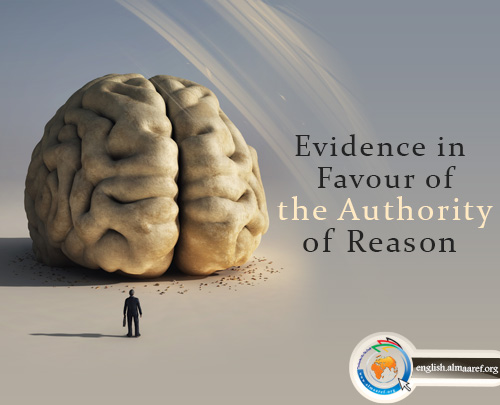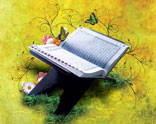Introduction
The Qur'an is a book of guidance; among its several names is Kitab al-Hikmah or the Book of Wisdom. The verses of the Qur'an are called ayath (signs), just as are the phenomena of nature: both speak forth the presence and worship of Allah. We shall show them Our portents on the horizon and within themselves until it will be manifest unto them that it is the Truth (Qur'an, 41: 53). In over 1100 verses, the importance of thinking, reflecting and pondering on the signs (natural phenomena) of Allah is emphasized; among these are. 2: 230, 242; 6:97-8; 10:24,67; 13:3-4; 14:25; 16:11-13, 44. 67-9, 90; 20:54; 23:30; 26:8; 28:43; 29:44; 30:20-9; 37:55; 38:29 39:18,21,27,42; 45:3-5,13; 51:49; 59:21. The greatest gift of Allah to man is the ability to think which distinguishes him from all the animals on earth. The Qur'an declares that the universe and all that there is in it is created by Allah as a 'sign', a manifestation of His mercy, power and wisdom. It is also a manifestation of His bounty and goodness; for He has created things for man's benefit. Mankind is enjoined to consider Allah's handiwork, to reflect on the wonders of His creation.
As man was created with an insatiable desire for knowledge, God made adequate arrangements for him to know the hidden secrets of the universe and taught him the nature and names of all things (2:31). Then all the powers and treasures of the heavens and the earth were made subject to him.
﴾He has subjected to you, as from Him, all that is in the heavens and on the earth; Surely in that are signs for those who reflect﴿. (45:13)
He has made subject to you the night and the day; the sun and the moon; and the stars
﴾Are in subjection by His Command; Verily in this are signs for men of understanding﴿. (16:12)
﴾It is He who made the sea subject, that you may eat thereof flesh that is fresh and tender, and that you may extract there from ornaments to wear; and you see the ships thereon that plough the waves, that you seek (thus) of the bounty of God and that you may be grateful.﴿ (16:14)
The Holy Qur'an: the fountainhead of the sciences
Is it not a fact that modern civilization is dedicating and devoting its time to various observations and experiments on the forces of nature, after the Muslims, inspired and enlightened by the teachings of the Qur'an set them upon this path? It is following their efforts and pioneering example that nature has been harnessed by science and technology in the West. The human mind was lacking in fertility till the bright rays of the Qur'an awakened the human race, and spread its light to the four corners of the world.
In his book New Researches into Compositions and Exegesis of the Qur'an Dr. Hartwig Hirschfeld says: We must not be surprised to find the Qur'an the fountainhead of sciences. Every subject connected with heaven or earth, human life, commerce and various trades are occasionally touched upon and this gave rise to the production of numerous monographs forming commentaries on parts of the Holy (Noble) Book. In this way the Qur'an was responsible for great discussions, and to it was indirectly due to the marvelous development of all branches of science in the Muslim world. This again not only affected the Arabs, but also induced Jewish philosophers to treat metaphysical and religious questions after Arab methods (Hirschfeld, 1902).
Spiritual activity once aroused within Islamic bounds was not confined to theological speculations alone. Acquaintance with the philosophical, astronomical and medical writings of the Greeks led to the pursuance of these studies. In the descriptive revelations Muhammad (sallallahu 'alayhi wa sallam) repeatedly calls attention to the movement of the heavenly bodies, as parts of the miracle of Allah forced into the service of man and therefore not to be worshipped. (Ibid.)
George Sarton, a Professor in the history of science at Harvard University, stated in his book The Life of Science that the foundations of science were laid for us by the Mesopotamian civilization (present day Iraq) whose scholars and scientists were their priests. The second development in science came through the Greeks. The third stage of development, however, is to be credited to the meteoric rise of Islam. For nearly four hundred years Islam led the scientific world as, from Spain to India the great body of past knowledge was exchanged between Muslim scholars and carried forward with new discoveries and new ideas. Scholars in Christendom, from about the eleventh century, were mainly occupied for over two hundred years in translating from Arabic into Latin. Thus Islam paved the way for the European Renaissance, which in turn led to science's fourth great development in the modem world (Sarton. 1971, pp. 146-166).
To be sure, the Qur'an is not, in any direct, literal sense a science textbook. Nevertheless, its verses, the words in it, directly awaken a scientific curiosity about the natural phenomena they mention. Just as in the past, so too now, the Qur'an can give a lead to inquiry and inquiry can lead to further reflection and experiment, returning the believer to a better understanding of the Qur'an. The following reflections on particular verses of the Qur'an are offered by way of illustrating this general point:
Beneficial effects of lightning
Of many Qur'anic verses, which have scientific import, these have a bearing on the phenomenon of lightning:
﴾It is He who shows you lightning, by way both of fear and of hope﴿ (13: 12)
﴾And among His signs He shows you the lightning by way both of fear and of hope, and he sends down rain from the sky and with it gives life to the earth after it is dead: Verily in that are signs for those who are wise.﴿ (30:24)
A. Yusuf Ali in his commentary on these verses (Notes 1818-19), says:
Why look to evil rather than to good? To punishment rather than to mercy? To the fear in the force and fire of the lightning rather than to hope of good and abundant crops in the rain which will come behind the lightning clouds.
Nay, thunder itself, which may frighten you, is but a tame and beneficent force before Him, declaring His praises like the rest of creation. THUNDER thus aptly gives the name to this Surah of contrasts, where what we may think is terrible is shown to be really a submissive instrument of good in God's hands.
Then, in Yusuf Ali's Note 3530, one reads:
To cowards lightning and thunder appear as terrible forces of nature: lightning seems to kill and destroy where its irresistible progress is not diverted by proper lightning conductors. But lightning is also a herald of rain-bearing clouds and showers that bring fertility and prosperity in their train ...
Newspapers and medical journals regularly publish articles on injury and death caused by lightning. However, the Qur'an specifically mentions 'hope' from lightning as well as fear. This is interpreted as 'hope' of good or beneficent force. What are the beneficial effects of lightning to mankind?
Positive and negative ions in the air
People often report feelings of pleasantness and well being following an electrical storm. Electrical storms at generally proceeded by higher levels of positive ions and followed by higher levels of' negative ions.
An ion is an atom or a molecule or group of molecules that has become electrically charged as a result of gaining or losing an electron. If a molecule has gained one or more electrons it is called a 'negative ion.' A free electron (which is not bound to the atom) is also called a negative ion. A positive ion is an atom or a molecule that has lost an electron.
There is considerable evidence for the beneficial effects of negative ions and unpleasant effects of positive ions. Scientists have investigated the possible relationship between health and the ion content of ambient air. As a result many of the health spas in Europe are located in areas having higher than normal level of negative ions.
Research indicates that ionization of the air has some effects on human behaviour. Negative ions are used to treat asthma, respiratory ailments, burns and post-operative pain. The negative ions have been observed to act as tranquillizers and patients experienced a feeling of calm. Productivity of factory workers increased and their disposition improved generally.
Patients suffering from respiratory diseases and allergies obtained relief usually within 0 to 30 minutes after entering a room in which a negative ion generator was at work. They could breathe normally and lost all symptoms such as sneezing, nasal and pulmonary congestion. Puritis (itching). Conjuctival irritation, etc. One medical researcher spent 49 consecutive nights in a heavily ionized atmosphere without any ill effects.
When young burn patients such as infants and children were exposed to negative ion producing machines, the first effect was an immediate reduction in pain. The need for analgesics (pain killers) was eliminated to a great extent. They relaxed, stopped crying and, apparently, became pain free after the first few hours. Furthermore the burns healed rapidly with a low rate of local infection.
Icy comets descending to the earth
In the part of the following verse, Allah is describing the formation of rain clouds and the rainfall from the clouds:
﴾Have you not seen how Allah wafts the clouds, then gathers them, then makes them layers, and you see the rain come forth from between them…﴿ (24.43. First half of the verse)
This phenomenon is a very common one and familiar to every human being. But not so well-known are the truths to be found in the following verse:
﴾And He causes water to descend from the heavens.﴿
(2:22; see also: 14:32. 16:65)
Here, Allah says that He causes water to descend from the heavens (skies), in contrast to 24:43.
﴾To understand this, one needs to understand the following verse whose full interpretation is possible only after recent discoveries have been made available.﴿
﴾He sends down from the Heavens Mountains wherein is hail ...﴿ (24:43. second-half of the verse)
This verse very clearly states that Allah sends down from the Heavens Mountains containing ice balls or comets of ice. Traditional commentators have long discussed the meaning of 'mountains in the sky'. Literally, the verse says: 'are sent from the skies from mountains of (from) cold'. The construction is in the passive voice. The Arabic word, min, appears three times. The first indicates the general origin of the rain in from the skies, the second specifies the origin further in from mountains, and the third describes of what the mountains consist of, what they contain or are characterized by, namely, cold. This led the early generations, among them the Prophet's Cousin Ibn 'Abbas, to conclude that 'there are mountains in the skies just as there are on the earth. 'Mountains' can be used figuratively to mean 'a great quantity', as when we say that so-and-so has 'mountains of gold' meaning 'he has a lot of gold'.
The language of the Qur'an is so rich that the verse could also mean that 'mountains of cold' Descend from the skies. Anyone who has been caught in a heavy winter hailstorm will readily understand the image. Most English translations render the Arabic word, baradin as hail. This is no doubt correct but something of the quality of the image is diminished. However, striking and powerful though the language and imagery, are, I shall concentrate attention here on the scientific implications of the words used in the verse.
Hail is 'frozen rain' or 'stones of frozen water' and can be aptly described as 'mountains' Descending from heaven or comets of ice. Now, several scientists have researched the hypothesis that the source of all the oceans is storms of icy comets that enter the earth's atmosphere at a rate of 20 per minute. These comets, which are believed to contain about 100 tons of water each, vaporize on impact with the atmosphere and fall as rain or snow.
The roots of this hypothesis are found in data received by the Dynamics Explorer 1 (DE 1), a High altitude, polar-orbiting satellite. The DE 1 had been conducting the first global exploratory Imaging mission of the earth. Professor Frank of Iowa University was interested in receiving the first global maps of the earth's aurora (Borealis). From a vantage point on the satellite, which orbits as far as 14,500 miles from earth, a photometer designed and operated by his team, measured the ultraviolet emissions from atomic oxygen in the atmosphere.
The bright or visible-half of the earth, illuminated by the sun, is known as the 'dayglow'. The Dayglow is caused by sunlight being absorbed and re-radiated by oxygen at 180 miles above the Earth's surface. Scientists use the dayglow to learn about the structure of the atmosphere at high altitude. The dayglow mages Frank received contained some unexpected features. He noticed the Sky was speckled with dark spots or atmospheric holes. Frank and his partners witnessed about 30,000 such spots or holes during their 2,000 hours of observation. They scrutinized the measurements for faulty instrumentation, possible computer glitches, statistical flaws, telemetry interference, failing sensors and paint flecks on the imager. After eliminating the possibility of spurious effects, the scientists published their results on the Atmospheric holes (Frank et al., 1986). The images revealed that the spots were about 30 miles wide and lasted up to three minutes. So what were they? How did they appear?
Frank concluded they were being caused by water vapor in the outer fringes of the atmosphere. He calculated that it would need a 30-foot ball of loosely packed water and ice breaking up and vaporizing about 1,000 to 2,000 miles away from the earth to produce a cloud of water vapor the size of the dark spots on his satellite images. He suggested that the holes in the dayglow were formed by small, comet-like objects entering the earth's atmosphere. Sixty miles from the earth's surface. the cloud of water vapor continues to plummet until it reaches a height of about 35 miles, where it gets mixed up with the air in the upper atmosphere. Winds circulating into the Stratosphere turn the water vapor into ice crystals, which then fall and become part of the lower Altitude's water vapor, eventually turning into precipitation and ending up in the sea. At the observed rate of 20 per minute, this is calculated to result in an increase of the equivalent of one Inch of water all over the earth's surface every 10,000 years.
Erikson (1938, p.20) suggested the barrage of icy comets began around 4.2 billion years ago, and that they were at their most intense during the 300 million years that followed. Dr Clayne Yeates, deputy project scientist at the Jet Propulsion Laboratory in Pasadena said that The comets of ice or snowballs continue to move at 10 kilometers per second relative to the Earth. At about 1,000 km above the earth they break up into hail due to tidal waves and then turn to vapor in the atmosphere. Finally, the vapor falls as rain and joins the earth's water cycle. Clayne Yeates (Huyghe, 1988) began a direct telescopic search for these small comets using the 36-inch Spacewatch Telescope at Kitt Peak, Arizona- one of the few telescopes in the world sufficiently sensitive to detect these small comets directly. These objects are too fast and too dark to be picked up on a photographic plate. Therefore, they used a charged coupled detector (CCD) that counts individual photons of light and is 100 times more sensitive than a photographic plate. The Spacewatch Telescope is just such an instrument. The objects are indeed there. Telltale streaks appeared on the telescope's images at the rate of more than one a minute, just as Frank had predicted.
Frank certainly did not set out to interpret the Qur'anic verse quoted above, nor does the imagery of the verse need any strengthening to be effective. Yet, may we not say that with every new observation of God's universe, sincerely motivated, we are enabled to see new shades of meanings in God's words?
* By: Ibrahim B. Syed, PhD.
- Erickson, J. (1987). The Living Earth. TAB Books, Inc., Blue Ridge Summit, Pennsylvania.
- Frank, L.A., Sigwarth, J.B., and Craven, J.D. (1986) 'On the influx of small comets into the Earth's upper atmosphere. II. Interpretation', Geophysical Research Letters, 13(4), pp.307-310.
- Hirschfeld, H. (1902) New Researches into Composition and Exegesis of the Qur'an. Royal Asiatic Society, London.
- Huyghe, P. (1986) 'The Origin of Oceans', Oceans, U.S.A. August, pp. 8-15.(1988) 'Oceans from Comets-New Evidence', Oceans, U.S.A., April, pp.8-11
- Sarton, G. (1971) The Life of Science: Essays in the History of Civilization. Books For Libraries Press, Free Port, NY.
- Syed, I.B. (2002) The Intellectual Achievements of Muslim, Islamic Circle, Mauritius
- Yilmaz, I and Ergi, O.A. (1993) 'Biology and Religion', The Fountain, 1(2) (April-June), London, pp. 15-17.




















